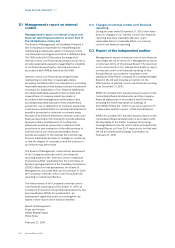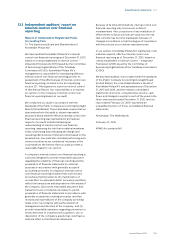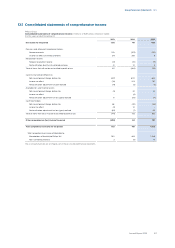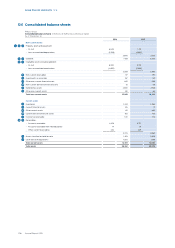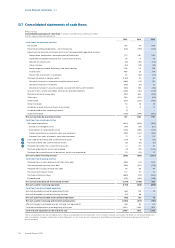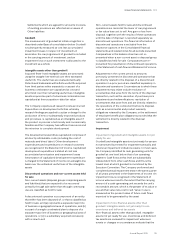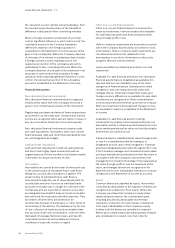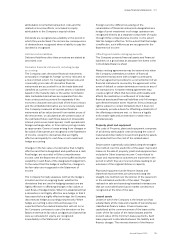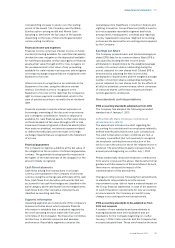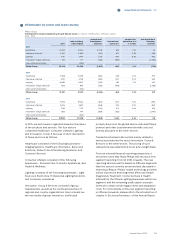Philips 2015 Annual Report Download - page 113
Download and view the complete annual report
Please find page 113 of the 2015 Philips annual report below. You can navigate through the pages in the report by either clicking on the pages listed below, or by using the keyword search tool below to find specific information within the annual report.Group nancial statements 12.9
Annual Report 2015 113
purchase of software for internal use and other
intangible assets are capitalized and subsequently
amortized over the estimated useful life.
Employee benet accounting
IFRS does not specify how an entity should present its
service costs related to pensions and net interest on the
net dened benet liability (asset) in the Statement of
income. With regards to these elements, the Company
presents service costs in Income from operations and
the net interest expenses related to dened benet
plans in Financial expense.
Cash ow statements
Under IFRS, an entity shall report cash ows from
operating activities using either the direct method
(whereby major classes of gross cash receipts and gross
cash payments are disclosed) or the indirect method
(whereby prot or loss is adjusted for the eects of
transactions of a non-cash nature, any deferrals or
accruals of past or future operating cash receipts or
payments, and items of income or expense associated
with investing or nancing cash ows). In this respect,
the Company chose to prepare the cash ow
statements using the indirect method.
Furthermore, interest cash ows are presented in cash
ows from operating activities rather than nancing or
investing cash ows, because they enter into the
determination of prot or loss. The Company chose to
present dividends paid to shareholders of Koninklijke
Philips N.V. as a component of cash ows from nancing
activities, rather than to present such dividends as
operating cash ows which is an allowed alternative
under IFRS.
Policies that are more critical in nature
Revenue recognition
Revenue from the sale of goods in the course of the
ordinary activities is measured at the fair value of the
consideration received or receivable, net of returns,
trade discounts and volume rebates. Revenue for sale
of goods is recognized when the signicant risks and
rewards of ownership have been transferred to the
buyer, recovery of the consideration is probable, the
associated costs and possible return of the goods can
be estimated reliably, there is no continuing
involvement with goods, and the amount of revenue
can be measured reliably. If it is probable that discounts
will be granted and the amount can be measured
reliably, then the discount is recognized as a reduction
of revenue as the sales are recognized.
Transfer of risks and rewards varies depending on the
individual terms of the contract of sale. For consumer-
type products in the sectors Lighting and Consumer
Lifestyle these criteria are met at the time the product
is shipped and delivered to the customer and title and
risk have passed to the customer (depending on the
delivery conditions) and acceptance of the product has
been obtained. Examples of delivery conditions are
‘Free on Board point of delivery’ and ‘Costs, Insurance
Paid point of delivery’, where the point of delivery may
be the shipping warehouse or any other point of
destination as agreed in the contract with the customer
and where title and risk for the goods pass to the
customer.
Revenues of transactions that have separately
identiable components are recognized based on their
relative fair values. These transactions mainly occur in
the Healthcare sector and include arrangements that
require subsequent installation and training activities in
order to become operable for the customer. However,
since payment for the equipment is contingent upon
the completion of the installation process, revenue
recognition is generally deferred until the installation
has been completed and the product is ready to be
used by the customer in the way contractually agreed.
Revenues are recorded net of sales taxes, customer
discounts, rebates and similar charges. For products for
which a right of return exists during a dened period,
revenue recognition is determined based on the
historical pattern of actual returns, or in cases where
such information is not available, revenue recognition
is postponed until the return period has lapsed. Return
policies are typically based on customary return
arrangements in local markets.
In case of loss under a sales agreement, the loss is
recognized immediately.
Shipping and handling billed to customers is
recognized as revenues. Expenses incurred for shipping
and handling of internal movements of goods are
recorded as cost of sales. Shipping and handling related
to sales to third parties are recorded as selling
expenses. When shipping and handling is part of a
project and billed to the customer, then the related
expenses are recorded as cost or sales. Service revenue
related to repair and maintenance activities for goods
sold is recognized ratably over the service period or as
services are rendered.
A provision for product warranty is made at the time of
revenue recognition and reects the estimated costs of
replacement and free-of-charge services that will be
incurred by the Company with respect to the products.
For certain products, the customer has the option to
purchase an extension of the warranty, which is
subsequently billed to the customer. Revenue
recognition occurs on a straight-line basis over the
extended warranty contract period.
Revenue from services is recognized when the
Company can reliably measure the amount of revenue
and the associated cost related to the stage of
completion of a contract or transaction, and the
recovery of the consideration is considered probable.
Royalty income, which is generally earned based upon



